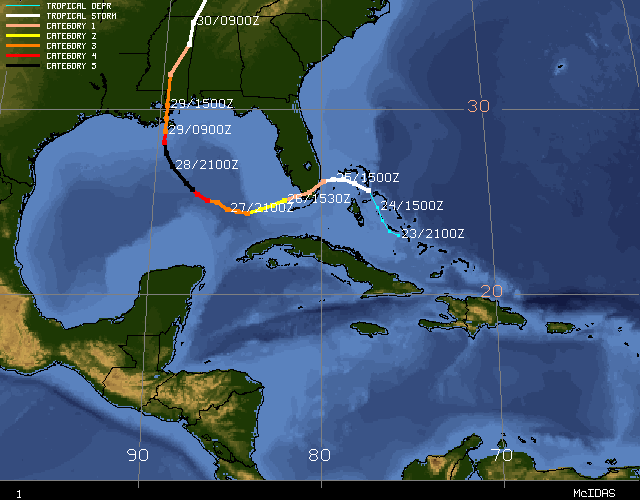
"As the computers get faster, the computer model's resolution increases, the ability to see higher and finer detail in the atmosphere increases. Watches are now issued 48 hours in advance, and warnings come 36 ahead of the storm. Not only has storm tracking become more accurate but James Franklin, the chief of forecast for the center, told CBS News that NOAA has been able in the past decade to increase the watch and warning times for hurricanes by 12 hours. "We know we still have work to do, but I can say we're in a much better place now because of the investments made over the past decade," Kathyrn Sullivan, NOAA's administrator and the Under Secretary of Commerce for Oceans and Atmosphere, told reporters last month. The smaller size of the potential path (shown in the white area) in the 2015 version is a testament to the significant improvement of modeling and forecast capabilities since Katrina made landfall. The original forecast from 2005 is shown on the right. On the left, a forecast run in 2015 uses more advanced techniques to narrow the predicted path of the storm. These graphics show the forecast path and estimated uncertainty for Hurricane Katrina with a three-day lead. In 2005 the average seasonal tracking error in a 48-hour forecast of where a storm would end up was 110 nautical miles. Thanks to a network of GEO stationary and polar orbiting satellites providing better data, faster super-computers, and improved modeling, forecasters at NOAA's National Hurricane Center have been able to reduce the margin of error in predicting a hurricane's path by almost half. While there are still several years left on the program, NOAA said forecasting has significantly improved. In 2008, NOAA launched a project to improve hurricane forecasts, vowing to increase the accuracy of storm tracking and intensity by 50 percent within a decade. The extent of the destruction and the heightened hurricane activity increased concerns about the dangers of hurricanes and prompted soul searching inside and outside of the National Oceanic and Atmospheric Administration over its ability to forecast these storms. Over the course of that hurricane season, 4,000 people lost their lives - half of those in Katrina - and property damage reached nearly $160 billion. The year 2005 was among the busiest hurricane seasons on record, not only bringing Katrina to the Gulf Coast in August but also Rita, which hit Texas and Louisiana less than a month later, and then Wilma, which struck Florida's southwest coast in October. The radar indicates rainfall intensity - the brighter colors (yellows, oranges) indicate heavier rainfall. Had they done that, it would have saved a lot of lives." This radar image from NOAA's National Weather Service shows Katrina making landfall on August 29, 2005. "In Katrina I think, in 2005, there was still enough uncertainty in the forecast, even though it was a good one, that they weren't ready to pull the trigger on an evacuation two days in advance. "The public has to have confidence that the forecast won't only be good in one case but will be good all the time," he said. "Part of it is confidence," Chris Velden, a senior scientist and hurricane researcher at the University of Wisconsin, Madison, told CBS News. That, in turn, has prompted mayors and governors, emergency management coordinators and average citizens to take action to get out of harm's way.


What this illustrates, experts say, is that the ability predict the path of such storms with a high degree of accuracy has gotten markedly better in the past decade. The response was different seven years later, when forecasters predicted the path of Hurricane Sandy, and New York and New Jersey officials responded swiftly to evacuate low-lying areas. In the end, the death toll was much higher than it should have been.

Officials delayed preparations and evacuation orders, and many residents hoped for the best, opting to wait out the storm. But there was still a measure of uncertainty, and not everyone heeded the warning. Katrina: Tracking the Course of a Killer Storm from Space 15 photosĪs Hurricane Katrina barreled towards New Orleans ten years ago, forecasters could see where it was heading.


 0 kommentar(er)
0 kommentar(er)
